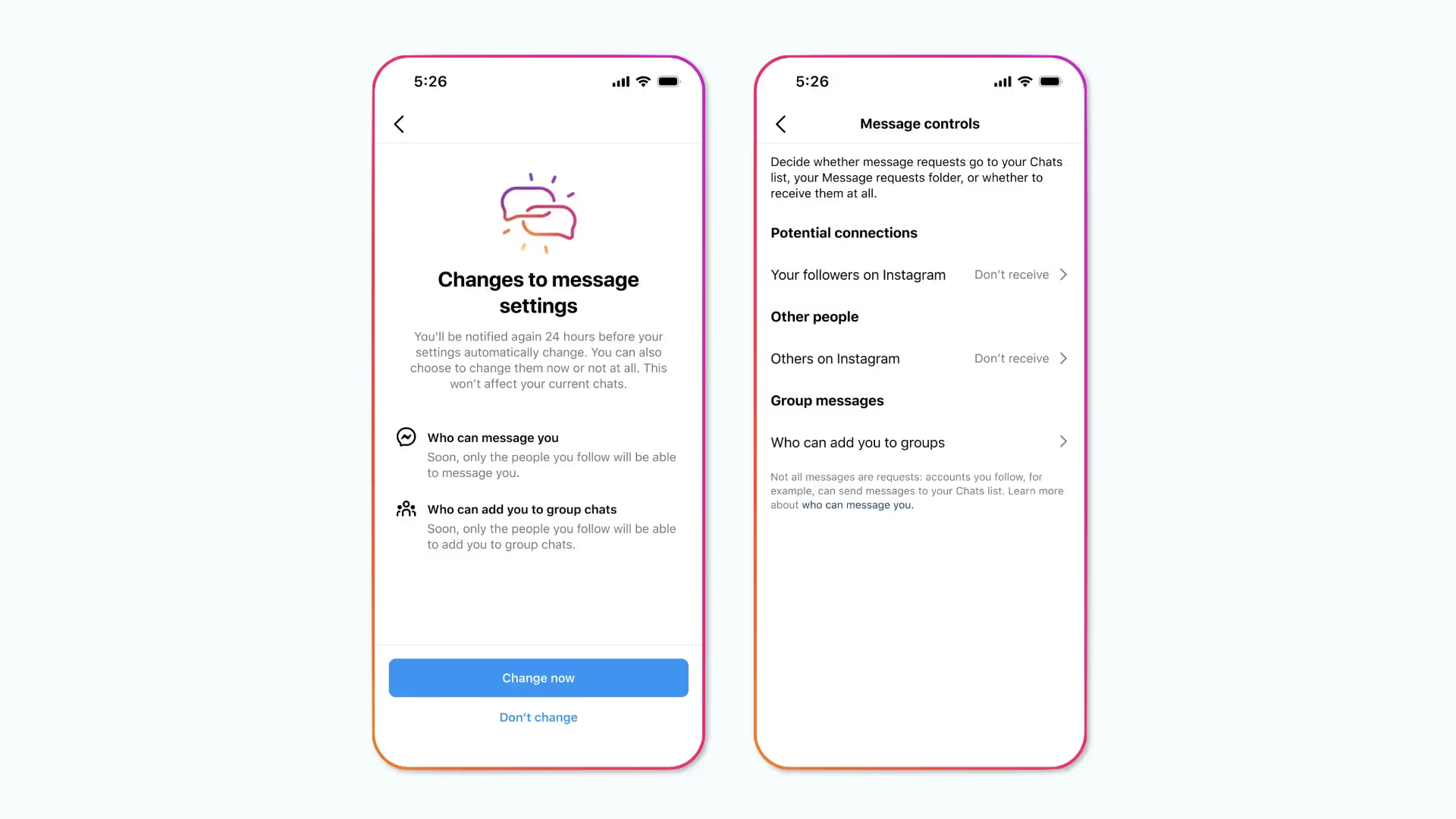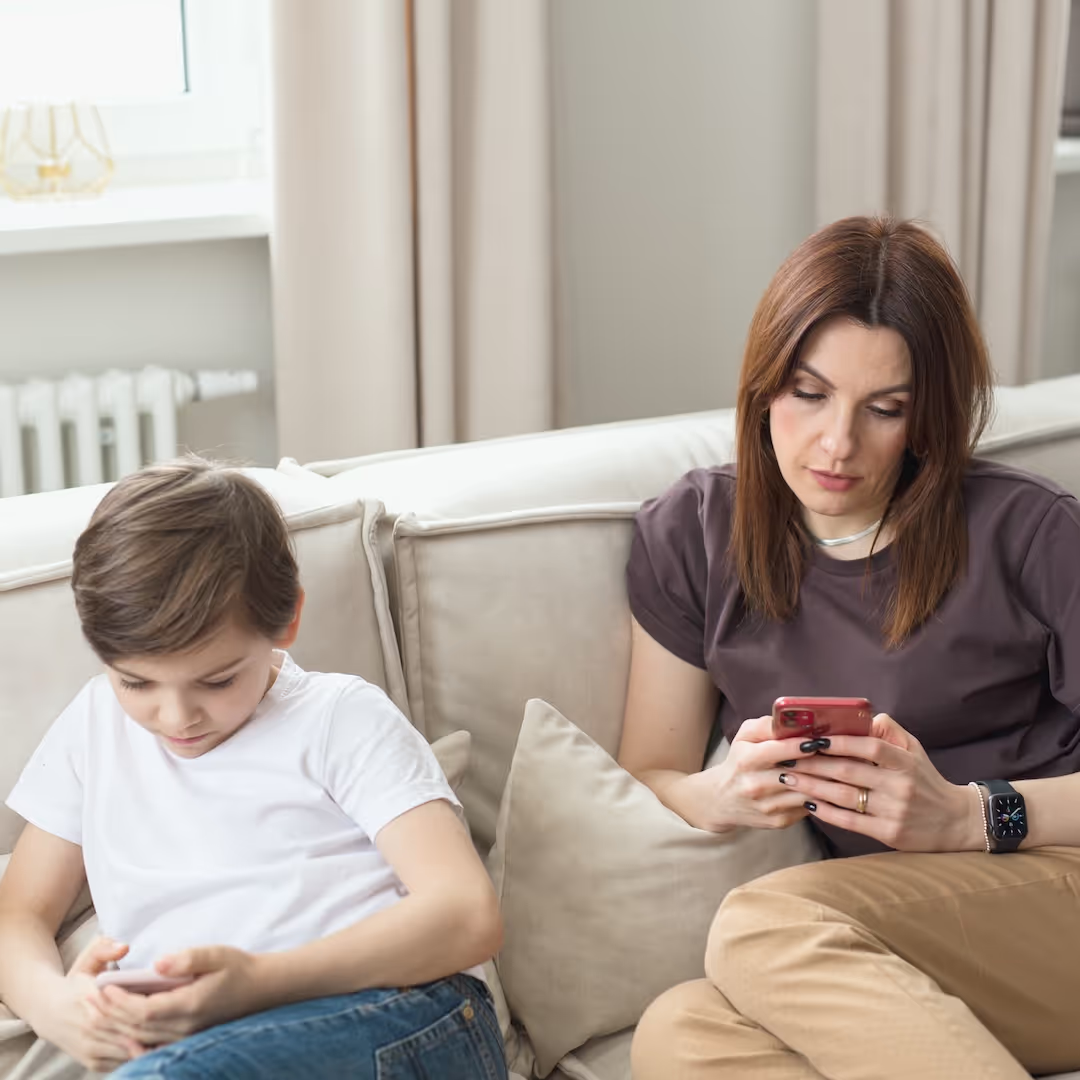


In making the three Screenagers movies, it has been shocking to me the number of teens who have shown me messages from strangers, usually over Instagram but other socials too. I am talking about inappropriate and creepy messages.
Thus, you can imagine my relief that FINALLY, last week, Meta, the parent company of Instagram, announced they would no longer allow teens under the age of 16 to receive direct messages on Instagram from anyone they are not connected to.
They said in the press release,
“To help protect teens from unwanted contact on Instagram, we restrict adults over the age of 19 from messaging teens who don’t follow them, and we limit the type and number of direct messages (DMs) people can send to someone who doesn’t follow them to one text-only message.”
Did it have to take this long?!? Instagram started 14 years ago.
Today, I write about how this works and other measures to help youth stay safe on Instagram. Before doing that, I want to share one key piece of parenting advice:
Inform your kids that although there are steps we can take to enhance safety in the digital world, it's important to acknowledge that they may still encounter unpleasant or inappropriate content. With this in mind, you might say something like, “It's crucial for you to understand safety first is my motto as a parent. I want you to feel like you can come to me about inappropriate interactions and material, friend conflicts — all of it — and I will be here to work with you on it and not automatically take your phone or other screen time away.”
It's wise to allow flexibility for possible temporary adjustments in their screen time. However, the key message is to acknowledge openly that bad things do indeed occur online. It's not a matter of if they might happen, but rather an acceptance that they do happen.
Now, let's discuss strategies to minimize negative experiences online. We'll cover the protective measures Meta has implemented and additional adjustments we can make through settings to enhance safety.
Learn more about showing our movies in your school or community!
Join Screenagers filmmaker Delaney Ruston MD for our latest Podcast

Learn more about our Screen-Free Sleep campaign at the website!
Our movie made for parents and educators of younger kids
Learn more about showing our movies in your school or community!
The latest settings prevent teens under age 16 from receiving direct messages on Instagram from people they don't follow or aren't connected with. This measure is designed to shield them from unsolicited contact. It's one of the numerous new safeguards Meta is implementing to enhance the safety of young users.
I am so happy that kids will be protected from strangers with dangerous agendas, but keeping the lines of communication open with your kids is still crucial, as I talked about earlier.
Having teens turn on their “Private” settings in their accounts is still important.
Talk with your teen and have them show you if they have this by having them go to settings and then Privacy, and make sure it is marked “Private Account.”
Some users, including teens, do not want their account set to “Private” for reasons such as one girl told me today: “I feel fine with everything I post, and so that is why I like it public. Also, it does increase my followers.”
I have asked people who keep their privacy settings set to “Private,” apart from appreciating the control over who views their posts, they also value the ability to see who wishes to connect with them.
You might be curious whether Meta's changes will affect users with their settings on “Public.” When discussing this with young people, many note that they do feel that even before now, there has been a reduction in strange people contacting them, but they say this should be enhanced.
The hope is that, even for users with “Public” settings, there will be a reduction in the number of inappropriate contacts reaching young people. Additionally, we hope to see fewer “Hidden Requests.”
“Hidden Requests” are akin to spam and can be concerning. The hope is that the Meta changes will address this.
This weekend, a girl shared one of the “Hidden Requests” on her Instagram account, which said,
“I am looking for a friend to hug in this room to have sex with.”
You will find Hidden Requests on Instagram's home page by
Take the time to talk to your teens about comment controls and resharing stories. In these controls, a person can determine who can comment, create specific filters for words and phrases, and not allow others to reshare stories. There is also a setting that does not allow pictures to be added to stories.
While I am very happy that Meta is finally taking steps to make their Instagram safer for some youth who use them, let's not forget about the other apps and more steps they can be doing to ensure the same, including educating your kids on the dangers of unsolicited contact.
It is as important as ever to foster open dialogue and communication with your kids so they have a healthy relationship with the digital world and know how to protect themselves.
**I wanted to let you know tomorrow, Wednesday, January 31st, the United States Senate Committee on the Judiciary is holding a hearing on online child sexual exploitation. The CEOs of the five major social media companies, Meta, TikTok, Snap, X, and Discord will testify. It would be a great thing to watch the recorded version with your teens too.
Learn more about showing our movies in your school or community!
Join Screenagers filmmaker Delaney Ruston MD for our latest Podcast

Learn more about our Screen-Free Sleep campaign at the website!
Our movie made for parents and educators of younger kids
Join Screenagers filmmaker Delaney Ruston MD for our latest Podcast
With new videos posted every Tuesday and Friday, be sure to subscribe to our YouTube Channel! Here's our latest videos!
In the latest episode of The Screenagers Podcast that just released, Dr. Delaney Ruston explores the complex issue of weed use among teenagers in today's digital world.
Listen to the full episode here: Apple Podcasts // Spotify // Website or here on our YouTube Channel!
As we’re about to celebrate 10 years of Screenagers, we want to hear what’s been most helpful and what you’d like to see next.
Please click here to share your thoughts with us in our community survey. It only takes 5–10 minutes, and everyone who completes it will be entered to win one of five $50 Amazon vouchers.
In making the three Screenagers movies, it has been shocking to me the number of teens who have shown me messages from strangers, usually over Instagram but other socials too. I am talking about inappropriate and creepy messages.
Thus, you can imagine my relief that FINALLY, last week, Meta, the parent company of Instagram, announced they would no longer allow teens under the age of 16 to receive direct messages on Instagram from anyone they are not connected to.
They said in the press release,
“To help protect teens from unwanted contact on Instagram, we restrict adults over the age of 19 from messaging teens who don’t follow them, and we limit the type and number of direct messages (DMs) people can send to someone who doesn’t follow them to one text-only message.”
Did it have to take this long?!? Instagram started 14 years ago.
Today, I write about how this works and other measures to help youth stay safe on Instagram. Before doing that, I want to share one key piece of parenting advice:
Inform your kids that although there are steps we can take to enhance safety in the digital world, it's important to acknowledge that they may still encounter unpleasant or inappropriate content. With this in mind, you might say something like, “It's crucial for you to understand safety first is my motto as a parent. I want you to feel like you can come to me about inappropriate interactions and material, friend conflicts — all of it — and I will be here to work with you on it and not automatically take your phone or other screen time away.”
It's wise to allow flexibility for possible temporary adjustments in their screen time. However, the key message is to acknowledge openly that bad things do indeed occur online. It's not a matter of if they might happen, but rather an acceptance that they do happen.
Now, let's discuss strategies to minimize negative experiences online. We'll cover the protective measures Meta has implemented and additional adjustments we can make through settings to enhance safety.
The latest settings prevent teens under age 16 from receiving direct messages on Instagram from people they don't follow or aren't connected with. This measure is designed to shield them from unsolicited contact. It's one of the numerous new safeguards Meta is implementing to enhance the safety of young users.
I am so happy that kids will be protected from strangers with dangerous agendas, but keeping the lines of communication open with your kids is still crucial, as I talked about earlier.
Having teens turn on their “Private” settings in their accounts is still important.
Talk with your teen and have them show you if they have this by having them go to settings and then Privacy, and make sure it is marked “Private Account.”
Some users, including teens, do not want their account set to “Private” for reasons such as one girl told me today: “I feel fine with everything I post, and so that is why I like it public. Also, it does increase my followers.”
I have asked people who keep their privacy settings set to “Private,” apart from appreciating the control over who views their posts, they also value the ability to see who wishes to connect with them.
You might be curious whether Meta's changes will affect users with their settings on “Public.” When discussing this with young people, many note that they do feel that even before now, there has been a reduction in strange people contacting them, but they say this should be enhanced.
The hope is that, even for users with “Public” settings, there will be a reduction in the number of inappropriate contacts reaching young people. Additionally, we hope to see fewer “Hidden Requests.”
“Hidden Requests” are akin to spam and can be concerning. The hope is that the Meta changes will address this.
This weekend, a girl shared one of the “Hidden Requests” on her Instagram account, which said,
“I am looking for a friend to hug in this room to have sex with.”
You will find Hidden Requests on Instagram's home page by
Take the time to talk to your teens about comment controls and resharing stories. In these controls, a person can determine who can comment, create specific filters for words and phrases, and not allow others to reshare stories. There is also a setting that does not allow pictures to be added to stories.
While I am very happy that Meta is finally taking steps to make their Instagram safer for some youth who use them, let's not forget about the other apps and more steps they can be doing to ensure the same, including educating your kids on the dangers of unsolicited contact.
It is as important as ever to foster open dialogue and communication with your kids so they have a healthy relationship with the digital world and know how to protect themselves.
**I wanted to let you know tomorrow, Wednesday, January 31st, the United States Senate Committee on the Judiciary is holding a hearing on online child sexual exploitation. The CEOs of the five major social media companies, Meta, TikTok, Snap, X, and Discord will testify. It would be a great thing to watch the recorded version with your teens too.
With new videos posted every Tuesday and Friday, be sure to subscribe to our YouTube Channel! Here's our latest videos!
In the latest episode of The Screenagers Podcast that just released, Dr. Delaney Ruston explores the complex issue of weed use among teenagers in today's digital world.
Listen to the full episode here: Apple Podcasts // Spotify // Website or here on our YouTube Channel!
Sign up here to receive the weekly Tech Talk Tuesdays newsletter from Screenagers filmmaker Delaney Ruston MD.
We respect your privacy.
In making the three Screenagers movies, it has been shocking to me the number of teens who have shown me messages from strangers, usually over Instagram but other socials too. I am talking about inappropriate and creepy messages.
Thus, you can imagine my relief that FINALLY, last week, Meta, the parent company of Instagram, announced they would no longer allow teens under the age of 16 to receive direct messages on Instagram from anyone they are not connected to.
They said in the press release,
“To help protect teens from unwanted contact on Instagram, we restrict adults over the age of 19 from messaging teens who don’t follow them, and we limit the type and number of direct messages (DMs) people can send to someone who doesn’t follow them to one text-only message.”
Did it have to take this long?!? Instagram started 14 years ago.
Today, I write about how this works and other measures to help youth stay safe on Instagram. Before doing that, I want to share one key piece of parenting advice:
Inform your kids that although there are steps we can take to enhance safety in the digital world, it's important to acknowledge that they may still encounter unpleasant or inappropriate content. With this in mind, you might say something like, “It's crucial for you to understand safety first is my motto as a parent. I want you to feel like you can come to me about inappropriate interactions and material, friend conflicts — all of it — and I will be here to work with you on it and not automatically take your phone or other screen time away.”
It's wise to allow flexibility for possible temporary adjustments in their screen time. However, the key message is to acknowledge openly that bad things do indeed occur online. It's not a matter of if they might happen, but rather an acceptance that they do happen.
Now, let's discuss strategies to minimize negative experiences online. We'll cover the protective measures Meta has implemented and additional adjustments we can make through settings to enhance safety.

It feels like we’re finally hitting a tipping point. The harms from social media in young people’s lives have been building for far too long, and bold solutions can’t wait any longer. That’s why what just happened in Australia is extremely exciting. Their new nationwide move marks one of the biggest attempts yet to protect kids online. And as we released a new podcast episode yesterday featuring a mother who lost her 14-year-old son after a tragic connection made through social media, I couldn’t help but think: this is exactly the kind of real-world action families have been desperate for. In today’s blog, I share five key things to understand about what Australia is doing because it’s big, it’s controversial, and it might just spark global change.
READ MORE >
I hear from so many parents who feel conflicted about their own phone habits when it comes to modeling healthy use for their kids. They’ll say, “I tell my kids to get off their screens, but then I’m on mine all the time.” Today I introduce two moms who are taking on my One Small Change Challenge and share how you can try it too.
READ MORE >
This week’s blog explores how influencers and social media promoting so-called “Healthy” ideals — from food rules to fitness fads — can quietly lead young people toward disordered eating. Featuring insights from Dr. Jennifer Gaudiani, a leading expert on eating disorders, we unpack how to spot harmful messages and start honest conversations with kids about wellness, body image, and what “healthy” really means.
READ MORE >for more like this, DR. DELANEY RUSTON'S NEW BOOK, PARENTING IN THE SCREEN AGE, IS THE DEFINITIVE GUIDE FOR TODAY’S PARENTS. WITH INSIGHTS ON SCREEN TIME FROM RESEARCHERS, INPUT FROM KIDS & TEENS, THIS BOOK IS PACKED WITH SOLUTIONS FOR HOW TO START AND SUSTAIN PRODUCTIVE FAMILY TALKS ABOUT TECHNOLOGY AND IT’S IMPACT ON OUR MENTAL WELLBEING.
